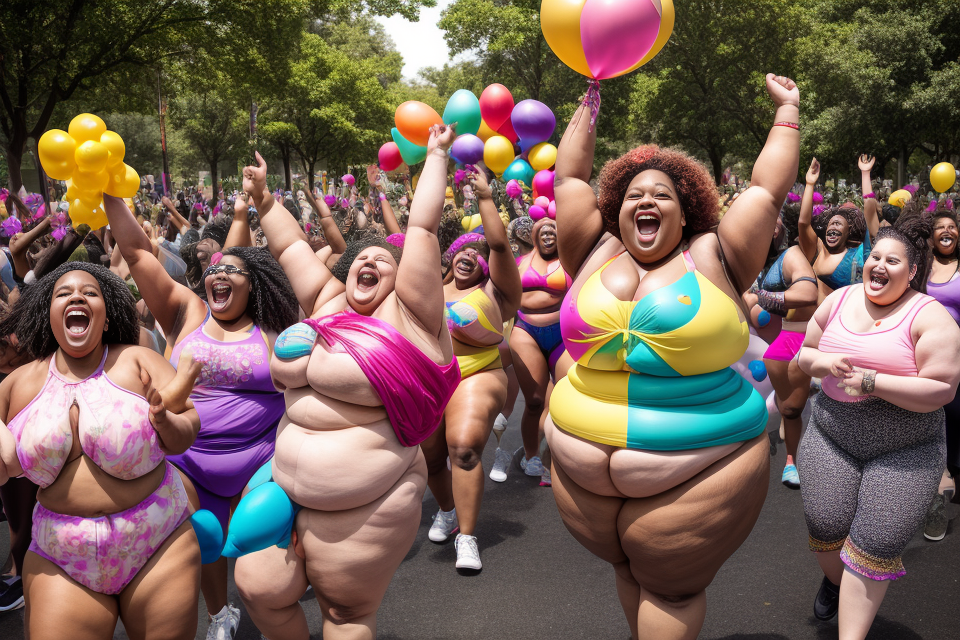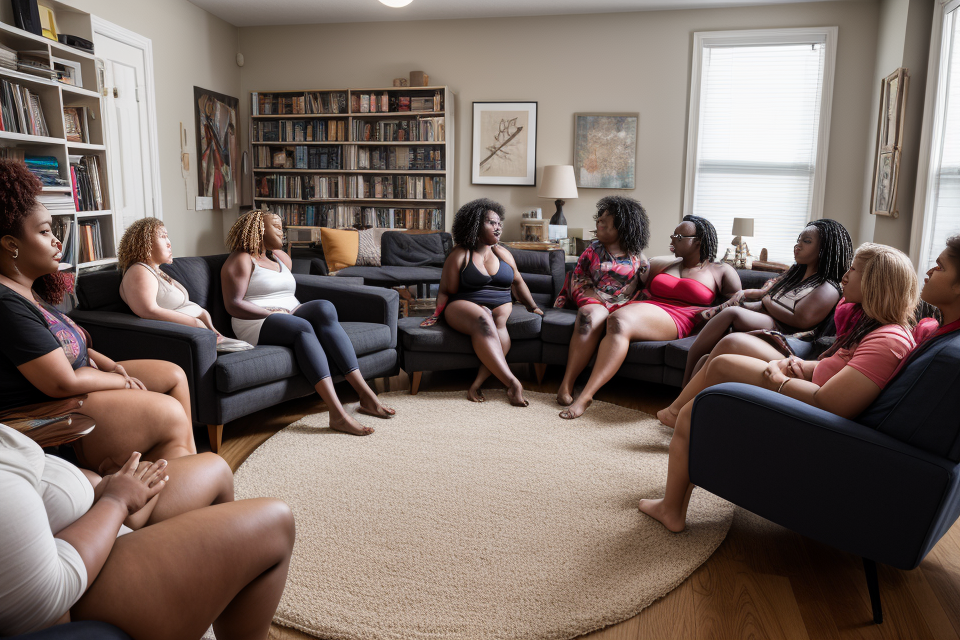
Body positivity is a movement that encourages individuals to embrace and love their bodies, regardless of size, shape, or appearance. It has gained significant traction in recent years, with more people speaking out against unrealistic beauty standards and promoting self-love and acceptance. But when did this movement take off?
The roots of the body positivity movement can be traced back to the 1960s and 1970s, when the feminist movement began to challenge traditional beauty standards and promote self-acceptance. However, it wasn’t until the early 2000s that the movement gained mainstream attention, thanks in part to the rise of social media.
Social media platforms like Instagram and Tumblr provided a space for individuals to share their stories and promote body positivity, leading to a wider conversation about body image and self-acceptance. Influential figures like model and body activist Tess Holliday also helped to bring the movement into the spotlight, challenging traditional beauty standards and promoting body positivity on a larger scale.
Today, the body positivity movement continues to gain momentum, with more people than ever before embracing self-love and body acceptance. Whether through social media, activism, or everyday conversations, the movement is helping to change the way we think and talk about our bodies, one person at a time.
The body positivity movement took off in the mid-2010s as a response to the thin and unrealistic beauty standards perpetuated by the media and society. It encouraged individuals to embrace and love their bodies, regardless of size or shape, and to challenge societal expectations surrounding beauty and body image. The movement gained momentum through social media, with influencers and everyday people sharing their stories and promoting body positivity. Today, the body positivity movement continues to inspire and empower individuals to love and accept their bodies, and to fight against harmful beauty standards and discrimination based on body size.
The Emergence of Body Positivity
The Origins of Body Positivity
The origins of body positivity can be traced back to the 1960s and 1970s, a time of significant social and cultural change in the United States. During this period, the women’s liberation movement was gaining momentum, and there was a growing awareness of the ways in which society imposed restrictive and limiting expectations on individuals based on their gender, race, and body size.
One of the key figures in the early development of body positivity was the feminist activist and writer, Betty Friedan. In her 1963 book, “The Feminine Mystique,” Friedan challenged the idea that women should be confined to the domestic sphere and argued that they should have access to education and career opportunities. She also wrote about the negative impact of the cultural ideal of thinness on women’s self-esteem and mental health.
Another important influence on the development of body positivity was the African American civil rights movement. In the 1960s and 1970s, activists working for racial equality began to challenge the dominant cultural norms that favored certain body types over others. They argued that these norms were part of a broader system of oppression that perpetuated inequality and discrimination based on race, gender, and body size.
The body positivity movement also drew inspiration from the gay liberation movement, which emerged in the late 1960s and early 1970s. Activists in this movement challenged the dominant cultural norms that associated homosexuality with weakness, immorality, and mental illness. They argued that all individuals, regardless of their sexual orientation or body size, should be accepted and celebrated for who they are.
Overall, the origins of body positivity can be seen as a response to the dominant cultural norms of thinness and beauty standards that favored certain body types over others. The movement sought to challenge these norms and promote acceptance and appreciation of all body types.
The Resurgence of Body Positivity in the 21st Century
In the 21st century, the body positivity movement experienced a resurgence, fueled by social media and the rise of influencers who championed body acceptance and self-love. This new wave of body positivity aimed to challenge unrealistic beauty standards and promote a more inclusive and diverse representation of bodies.
The resurgence of body positivity in the 21st century can be attributed to several factors:
- The rise of social media platforms, such as Instagram and Tumblr, which provided a space for individuals to share their experiences and perspectives on body image and self-acceptance.
- The emergence of influencers, such as Megan Jayne Cottrell and Tess Holliday, who used their platforms to promote body positivity and challenge traditional beauty standards.
- The growing awareness of the negative impact of traditional beauty standards on mental health and self-esteem, leading to a greater demand for more inclusive and diverse representations of bodies.
- The increasing visibility of diverse bodies in mainstream media and advertising, as well as the growth of the plus-size fashion industry, which provided more options for individuals of all sizes to express their style and individuality.
Overall, the resurgence of body positivity in the 21st century marked a significant shift in the way society talked about and perceived bodies, paving the way for a more inclusive and accepting culture.
The Impact of Body Positivity
Changing Beauty Standards
The body positivity movement has had a profound impact on changing beauty standards, encouraging individuals to reject societal pressures to conform to unrealistic ideals and embrace their unique bodies. This shift has led to a greater appreciation of diversity and the recognition that beauty comes in all shapes and sizes.
One of the most significant changes brought about by the body positivity movement is the rejection of the “thin ideal” that has long been perpetuated by the media and society at large. This has led to a greater appreciation of all body types, including those that are not traditionally considered “beautiful” or “acceptable.”
Another important aspect of the body positivity movement is the recognition that beauty is not just about appearance, but also about self-acceptance and self-love. This has led to a greater focus on inner beauty and the idea that all individuals have something unique and valuable to offer.
The body positivity movement has also led to a greater recognition of the importance of representation in the media. By featuring a wider range of body types in advertising and entertainment, the movement has helped to normalize diversity and promote a more inclusive view of beauty.
Overall, the body positivity movement has had a significant impact on changing beauty standards, encouraging individuals to embrace their unique bodies and promoting a more inclusive and accepting view of beauty.
Mental Health Benefits
Increased Self-Esteem
Embracing body positivity has been shown to boost self-esteem in individuals. By accepting and celebrating their bodies, people are able to feel more confident and secure in their own skin. This, in turn, can lead to improved overall mental health and well-being.
Body Satisfaction
Body positivity has also been linked to increased body satisfaction. By challenging societal beauty standards and promoting diversity, the movement encourages individuals to appreciate their bodies for what they are, rather than striving for an unattainable ideal. This can lead to a more positive relationship with one’s body and improved mental health outcomes.
Overall Well-Being
Overall, the body positivity movement has been shown to have a positive impact on mental health. By promoting self-love and acceptance, it has helped individuals develop a healthier relationship with their bodies, leading to increased self-esteem, body satisfaction, and overall well-being.
Criticisms and Controversies
One of the main criticisms of the body positivity movement is that it can perpetuate unhealthy behaviors and attitudes. Some argue that by promoting acceptance of all body types, the movement may inadvertently encourage individuals to maintain unhealthy habits, such as overeating or a lack of exercise. This concern is based on the idea that people may become complacent in their self-care and health choices, assuming that their body size is acceptable regardless of their lifestyle choices.
Another criticism is that the body positivity movement does not go far enough in challenging systemic issues related to body size and discrimination. Some argue that the focus on individual body acceptance detracts from the need for broader societal change, such as the promotion of diverse and inclusive spaces, as well as the elimination of weight-based discrimination in areas such as employment and healthcare.
Additionally, there are concerns that the body positivity movement may reinforce the idea that all body types are equally valuable and deserving of respect, regardless of the impact that they may have on others. For example, some argue that individuals who engage in dangerous or reckless behavior, such as drunk driving or extreme sports, may use the body positivity movement as a justification for their actions, claiming that their body size or shape gives them a right to engage in risky behavior.
Lastly, there are concerns that the body positivity movement may contribute to the commodification of bodies, with individuals and companies capitalizing on the trend by promoting unrealistic beauty standards and selling products that claim to improve one’s body image. This can lead to a perpetuation of harmful and unattainable beauty ideals, which may further contribute to negative body image and self-esteem issues.
The Future of Body Positivity
Ongoing Efforts to Promote Body Acceptance
Expanding Representation in Media and Advertising
One ongoing effort to promote body acceptance is the push for more diverse representation in media and advertising. This includes efforts to include a wider range of body types in fashion and beauty advertisements, as well as the representation of individuals with disabilities and different cultural backgrounds.
Campaigns to Address Fatphobia and Discrimination Based on Body Size
Another ongoing effort is the campaign to address fatphobia and discrimination based on body size. This includes raising awareness about the negative impact of fatphobia on mental health and well-being, as well as advocating for policies that promote body acceptance and self-love. Additionally, there are efforts to educate individuals and communities about the importance of respecting and valuing all body types, regardless of size.
Promoting Body Positive Spaces
In addition to these efforts, there are also ongoing initiatives to create body positive spaces, such as gyms and fitness classes that prioritize inclusivity and body acceptance. These spaces provide a safe and supportive environment for individuals of all shapes and sizes to engage in physical activity and promote self-love.
Encouraging Self-Love and Acceptance
Overall, the ongoing efforts to promote body acceptance aim to encourage self-love and acceptance of all body types. By promoting diversity and inclusivity in media and advertising, addressing fatphobia and discrimination, and creating body positive spaces, the body positivity movement continues to gain momentum and make a positive impact on individuals and communities.
Challenges and Opportunities Ahead
As the body positivity movement continues to gain momentum, it faces both challenges and opportunities in the future.
Addressing Systemic Issues
One of the biggest challenges facing the body positivity movement is addressing systemic issues related to body size and discrimination. Despite progress made in recent years, fatphobia and discrimination based on body size are still prevalent in many areas of society, including the workplace, healthcare, and media representation.
To address these systemic issues, the body positivity movement must continue to advocate for policies and practices that promote body diversity and inclusion. This includes advocating for larger clothing sizes, more inclusive healthcare practices, and increased representation of diverse body types in media and advertising.
Navigating Cultural Attitudes
Another challenge facing the body positivity movement is navigating the complexities of cultural and societal attitudes towards bodies. While some cultural attitudes towards bodies are shifting towards greater acceptance and inclusivity, others remain deeply entrenched and resistant to change.
For example, certain beauty standards and ideals are deeply ingrained in certain cultures, making it difficult to challenge them. Additionally, societal pressure to conform to certain beauty standards can be intense, particularly for individuals who do not fit into traditional beauty norms.
Embracing Diversity and Inclusion
Despite these challenges, the body positivity movement remains a powerful force for change, inspiring individuals to embrace their bodies and challenge unrealistic beauty standards. The movement must continue to embrace diversity and inclusion, celebrating the unique beauty and worth of all bodies, regardless of size, shape, or appearance.
Ultimately, the future of body positivity will depend on its ability to navigate these challenges and opportunities, continuing to inspire individuals to embrace their bodies and challenge unrealistic beauty standards.
FAQs
1. When did the body positivity movement start?
The body positivity movement began to gain traction in the early 2010s, with influencers on social media platforms like Tumblr and Instagram sharing their personal experiences with body image and self-acceptance. However, its roots can be traced back to the 1960s and 1970s, when the feminist movement began to challenge traditional beauty standards and promote the idea that all bodies are beautiful.
2. Who were some of the early influencers in the body positivity movement?
Some of the early influencers in the body positivity movement included bloggers and activists like Tess Holliday, Nadia Aboulhosn, and Glen Coco. These individuals used their platforms to share their experiences with body shaming and to promote self-love and acceptance.
3. What is the significance of the body positivity movement?
The body positivity movement has had a significant impact on how society views and talks about bodies. It has challenged traditional beauty standards and encouraged people to embrace their bodies as they are. The movement has also sparked conversations around issues like fatphobia, body shaming, and eating disorders, and has helped to create a more inclusive and accepting culture.
4. How has the body positivity movement evolved over time?
Over time, the body positivity movement has become more mainstream and has gained support from a wider range of individuals and organizations. It has also become more intersectional, with many advocates emphasizing the importance of recognizing the unique experiences of individuals from different backgrounds and communities.
5. What is the future of the body positivity movement?
The future of the body positivity movement is bright, with many individuals and organizations continuing to advocate for body acceptance and self-love. As society becomes more diverse and inclusive, it is likely that the movement will continue to grow and evolve, with a focus on creating a world where all bodies are celebrated and accepted.


